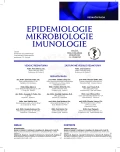Identification of bacteria from blood cultures by fluorescence in situ hybridization
Authors:
L. Černohorská; L. Dolinková
Authors‘ workplace:
Mikrobiologický ústav LF MU a FN u sv. Anny v Brně
Published in:
Epidemiol. Mikrobiol. Imunol. 66, 2017, č. 2, s. 86-90
Category:
Original Papers
Overview
The diagnosis of bacterial agents of sepsis from blood cultures is crucial for the subsequent treatment of this condition.
The aim of this study was to compare Gram stain, culture, and biochemical identification (conventional methods) and fluorescence in-situ hybridisation (FISH) that detects microorganisms from positive blood cultures using specific probes. Another aim was to evaluate the potential of this method for use in clinical practice.
Altogether 71 samples of positive blood cultures were tested by FISH. Blood cultures were also processed in the conventional way using the BACTEC analyser. The bacteria recovered were inoculated on solid media and then identified biochemically. The results obtained by the conventional methods and HemoFISH were not 100% concordant. The sensitivity of HemoFISH was 90.1%. Very good results were achieved for staphylococci and enterobacteria. FISH identification failed in three cases because the hybridization probes were not able to bind to bacterial rRNA.
The FISH bacterial identification is faster than the conventional methods, but should be confirmed by the latter.
KEYWORDS:
sepsis – blood cultures – Gram stain – fluorescence in situ hybridization
Sources
1. Almuhayawi M, et al. The performance of the four anaerobic blood culture bottles BacT/Alert-FN, -FN Plus, BACTEC-Plus and –Lytic in detection of anaerobic bacteria and identifiction by direct MALDI-TOF MS. PLoS One, 2015; 10 (11): 1–11.
2. Beneš J, et al. Infekční endokarditida. Doporučené postupy diagnostiky, léčby, dispenzarizace a profylaxe [On line]. 2007 [cit. 2017-01-01]. Dostupné na www: <http://www.kardio-cz.cz/data/upload/Infekcni_endokarditida_doporucene_postupy_diagnostiky_lecby_dispenzarizace_a_profylaxe.pdf>.
3. Blömeke E. About HemoFISH Miacom possibilities (Product manager, Miacom diagnostics GmbH I Merowingerplatz 1a, D-40225 Düsseldorf, Germany). Ústní sdělení dne 22. 10. 2013.
4. Dostál V. Horečnatý stav. In Beneš J. Infekční lékařství. Galén, 1. vydání; 2009 : 381–394.
5. Havlík J, et al. Sepse a septický šok. In Infekční nemoci. 2. vydání, Praha: Galén; 2002. 186 s.
6. Kočárek E, Pánek M, Novotná D. Klinická cytogenetika I. Úvod do klinické cytogenetiky: vyšetřovací metody v klinické cytogenetice. Praha: Karolinum; 2006, 134 s.
7. Kolář M. Sepse. In Antibiotická léčba nozokomiálních infekcí. Praha: Triton, 2000. s. 125–129.
8. Kula R, Chýlek V, Černý V. Sepse, infekce, antibiotická a antimykotická terapie. In Černý V, Matějovič M, Dostál P. Vybrané doporučené postupy v intenzivní medicíně. Praha: Maxdorf, 2009, s. 157–160.
9. Lamoth F, Jaton K, Prod'hom G et al. Multiplex blood PCR in combination with blood cultures for improvement of microbiological documentation of infection in febrile neutropenia. J Clin Microbiol, 2010; 48(10): 3510–3516.
10. Leitner E, Scherr S, Strempfl Ch, et al. Rapid identification of pathogens with the hemoFISH test applying a novel beacon-based Fluorescence In Situ Hybridization (bbFISH) technology in positive blood culture bottles. J Molecular Diagnostics, 2013; 15, 6 : 835–883.
11. Litzman J, et al. Základy vyšetření v klinické imunologii. Brno: Masarykova univerzita, 2007, 59 s.
12. Makristathis A, Riss S, Hirschl AM. A novel FISH test for rapid pathogen identification in positive blood cultures. Clin Microbiol Infect, 2014; 20(10): 0760-3.
13. Michalová K. Úvod do lidské cytogenetiky. Brno: Institut pro další vzdělávání pracovníků ve zdravotnictví; 1999. 172 s.
14. Nussbaum R L, McInnes RR, Willard HF. Klinická genetika. 6. vydání, Praha: Triton, 2004, 492 s.
15. Sakarikou Ch, Parisato M, Cascio G, et al. Beacon-based (bbFISH®) technology for rapid pathogens identification in blood cultures. BMC Microbiology, 2014; 14 : 99.
16. Singer M, Deutschman CS, Seymour CW, et al. The Third International Consensus Definitions for Sepsis and Septic Shock (Sepsis-3). JAMA, 2016; 315(8): 801–810.
17. Votava M. Vyšetřovací postupy. In Lékařská mikrobiologie obecná. Brno: Neptun, 2001, s. 203–212.
18. Zhou L, Jones C, Gibani MM, et al. Development and evaluation of a blood culture PCR assay for rapid detection of Salmonella Paratyphi A in clinical samples. Plos One, 2016; 11 (3): e.0150576.
Labels
Hygiene and epidemiology Medical virology Clinical microbiologyArticle was published in
Epidemiology, Microbiology, Immunology

2017 Issue 2
Most read in this issue
- Diagnostic relevance of the chemokine CXCL13 and anti-C6 peptide antibodies in patients with neuroborreliosis
- Cat scratch disease – a neglected zoonosis
- The common bed bug (Cimex lectularius) – biology, medical relevance, possibilities for the detection and control
- Sepsis-related mortality in the Czech Republic: multiple causes of death analysis
